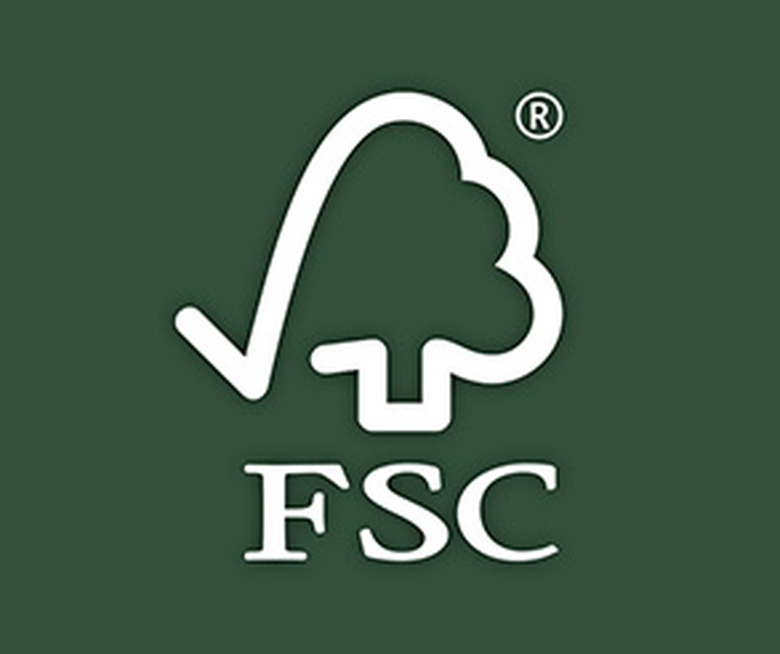What Is FSC-Certified Wood?
FSC is the abbreviation for the Forest Stewardship Council, an international nonprofit that promotes responsible forestry. The organization certifies forests across the globe, ensuring they're managed in an environmentally sound fashion that is economically viable without creating social harm. To receive the FSC's logo, which features the outline of a tree with a check mark on the left side, lumber—from imported hardwood to domestic cherry or oak—must meet the following standards:
- It must be legally harvested.
- It cannot violate traditional and human rights.
- It may not come from forests that are being turned into plantations or converted to non-forest use; in other words, it must come from managed forests with trees felled in a sustainable manner.
- There can be no genetically modified trees in the forest in which the lumber was felled.
- The lumber cannot have been harvested in forests the FSC has identified as being of high conservation value—for example, if they contain significant concentrations of biodiversity; they hold threatened, endangered, or rare ecosystems; they provide basic defenses such as erosion control or watershed protection; they're essential to meeting the basic needs of indigenous communities, such as subsistence; or they are crucial to the cultural identity of local populations.
Besides forest certification, the FSC maintains a certified chain of custody system that tracks the lumber through every stage of the process, from forest to retailer. Purchasing lumber with an FSC certification assures you that dwindling forests weren't harmed by its harvesting and helps to support sustainable forest management. A code on the label allows consumers to confirm the veracity of that claim on the FSC website.
The FSC website states: "There are a number of other forest certification schemes around, but they do not have the same strict environmental, social, and economic standards, or such a rigorous chain of custody: tracking timber from the forest to the final user. FSC is therefore the only forest certification scheme endorsed by the major environment charities, including WWF, Greenpeace, and the Woodland Trust."
Whether you're looking for framing lumber or sustainable wood flooring, seek out products carrying the FSC logo.
A Brief History of the Forest Stewardship Council
A Brief History of the Forest Stewardship Council
After an agreement to stop deforestation failed to come out of the 1992 Rio de Janeiro Earth Summit, some businesses, community leaders, and environmentalists united to form the Forest Stewardship Council. They met the next year in Toronto at the organization's first general assembly. There, they sought an alternative to forest-product boycotts, which had been found to devalue forests, and instead instituted a voluntary market-based approach that aimed to improve forest practices. The FSC Secretariat was originally headquartered in the forested region of Oaxaca, Mexico, but moved to Bonn, Germany, in 2003. The American chapter of the organization, established in 1995, has its home base in Minneapolis.
Since its inception, the Forest Stewardship Council has become prominent as the most rigorous forest certification system. It now operates in over 80 nations that have logging activity.
What Makes FSC Certification Unique?
What Makes FSC Certification Unique?
Other certification programs exist, but FSC holds the highest standards of forest management. It employs independent organizations to inspect forests to ensure they uphold the strict standards set by the FSC's 10 Principles of Forest Stewardship. These include the obvious: that forest managers comply with all laws, regulations, and international agreements. But the standards also protect forest workers from exploitation by making sure they're fairly treated and paid, and require forest managers to employ sustainable practices and properly manage ecosystems to minimize environmental impact. They also specify that forest managers on private as well as public lands uphold indigenous people's legal rights to forest use. This includes maintaining the well-being of local communities by including their concerns as part of the certification process. This requires directly engaging communities and addressing their concerns on any impacts of forest operations. Finally, the FSC also requires the public release of all certification audits, even those from private lands—a transparency that other forest certification programs lack.
The management standards also forbid the logging of old-growth forests, help protect water quality, forestall the loss of natural forest cover, and prohibit the use of hazardous chemicals. Some of these guidelines exceed national requirements. For example, the Forest Stewardship Council bans the use of atrazine—an herbicide that has been linked to birth defects and water pollution, and which, while prohibited in Europe, remains legal stateside. Less rigorous certification programs allow the chemical's use.
Where Can You Buy FSC-Certified Lumber?
Where Can You Buy FSC-Certified Lumber?
Home Depot was the first American company to sell (FSC)-certified lumber, starting in 1994. Lumber yards can also order FSC-certified wood for you if they don't ordinarily keep it in stock, though you may have to be persistent in your efforts. You may find it challenging to source lumber with an FSC certification, however. Luckily, the FSC website has a database which you can use to search for retailers. You can search it by a number of different ways, including company name or by the state you reside in.


